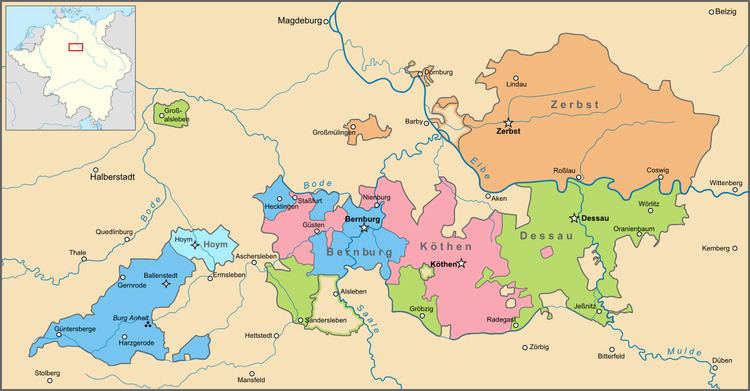Government Principality Partitioned 1603 Founded 1252 | Partitioned 1667 Date dissolved 1796 | |
 | ||
Anhalt-Zerbst was a principality of the Holy Roman Empire ruled by the House of Ascania, with its residence at Zerbst in present-day Saxony-Anhalt. It emerged as a subdivision of the Principality of Anhalt from 1252 until 1396, when it was divided into the principalities of Anhalt-Dessau and Anhalt-Köthen. Recreated in 1544, Anhalt-Zerbst finally was partitioned between Anhalt-Dessau, Anhalt-Köthen, and Anhalt-Bernburg in 1796 upon the extinction of the line.
Contents
History
It was created when the Anhalt territory was divided among the sons of Prince Henry I into the principalities of Anhalt-Aschersleben, Anhalt-Bernburg and Anhalt-Zerbst in 1252. In the course of the partition, Prince Siegfried I, the youngest son of Henry I, received the lands around Köthen, Dessau, and Zerbst. His son and successor Prince Albert I took his residence at Köthen Castle in 1295. In 1396, the surviving sons of Prince John II of Anhalt-Zerbst again divided their heritage: Sigismund I became Prince of Anhalt-Dessau and his younger brother Albert IV went on to rule as Prince of Anhalt-Köthen.
The principality was recreated, when in 1544 the heirs of Prince Ernest I of Anhalt-Dessau divided their territory and the eldest surviving son, Prince John V, took his residence at Zerbst Castle. The second incarnation, however, lost a lot of territory in 1603 when it was partitioned for a second time with some of its territory being given to Anhalt-Dessau, Anhalt-Bernburg, Anhalt-Plötzkau and Anhalt-Köthen.
By 1606, all Anhalt principalities had turned to the Reformed faith, however, Anhalt-Zerbst returned to Lutheranism in 1644. In 1667, Prince John VI inherited the remote Lordship of Jever in East Frisia. Upon his death in the same year, however, Anhalt-Zerbst lost more of its territory, with Anhalt-Mühlingen and Anhalt-Dornburg being created. The Jever lordship was administrated by Ascanian relatives, it was hit hard by the Christmas Flood of 1717.
The last Prince of Anhalt-Zerbst, Frederick Augustus was forced into exile, when Prussian forces invaded Anhalt during the Seven Years' War in 1758. Upon his death in 1793, the Principality of Anhalt-Zerbst came to an end with its territory being divided among the Ascanian princes of Anhalt-Dessau, Anhalt-Köthen, and Anhalt-Bernburg.
Princes, 1252–1396
Partitioned between Anhalt-Dessau and Anhalt-Köthen in 1396.
Princes, 1544–1796
To Anhalt-Dessau 1796.
